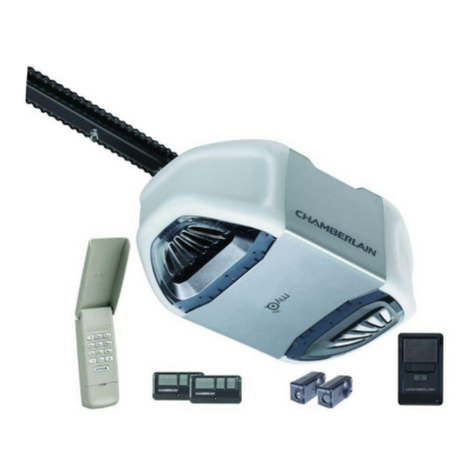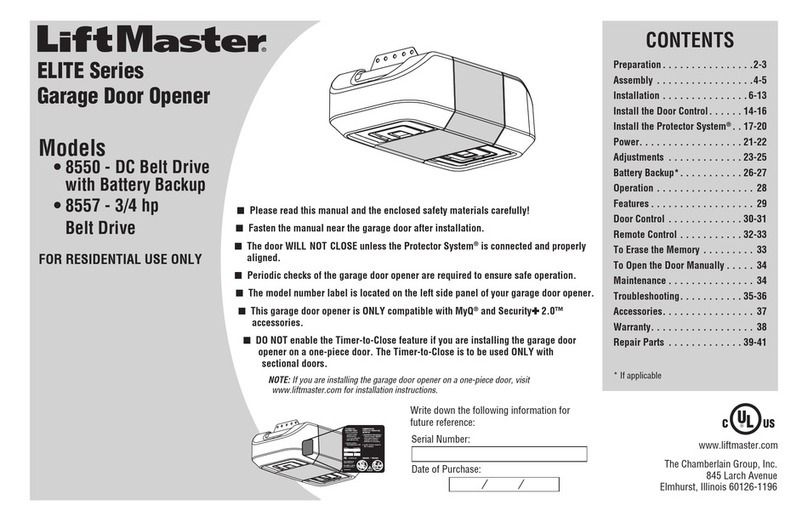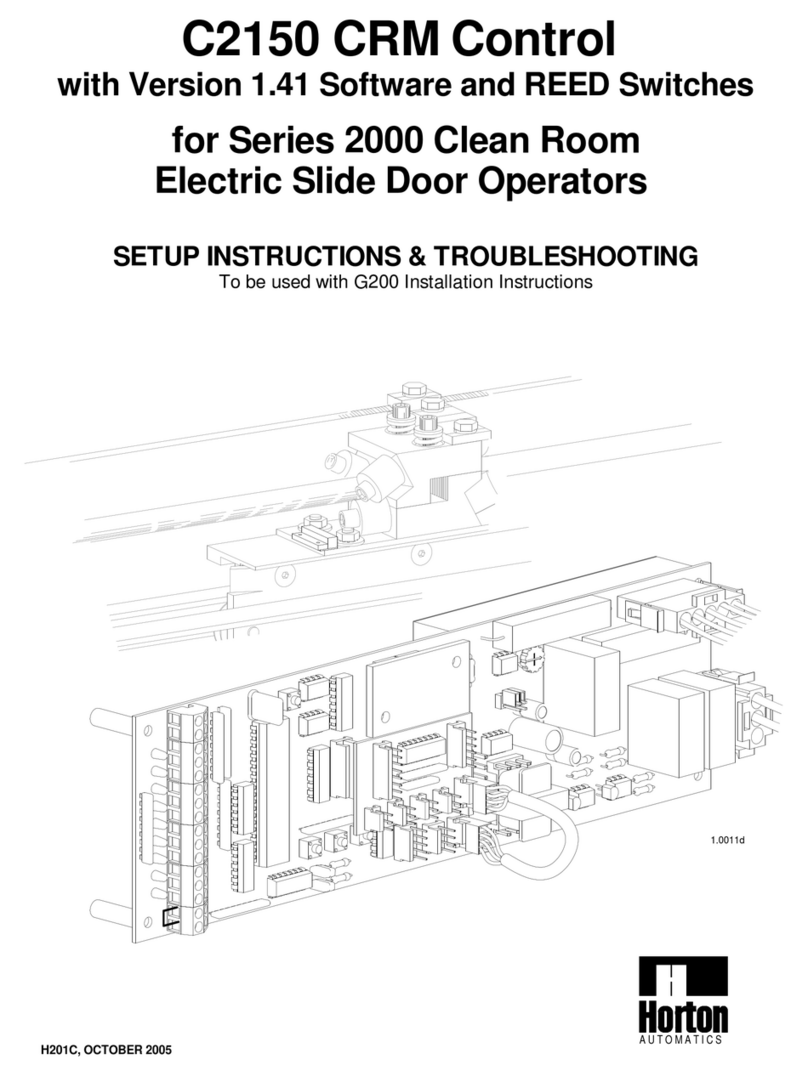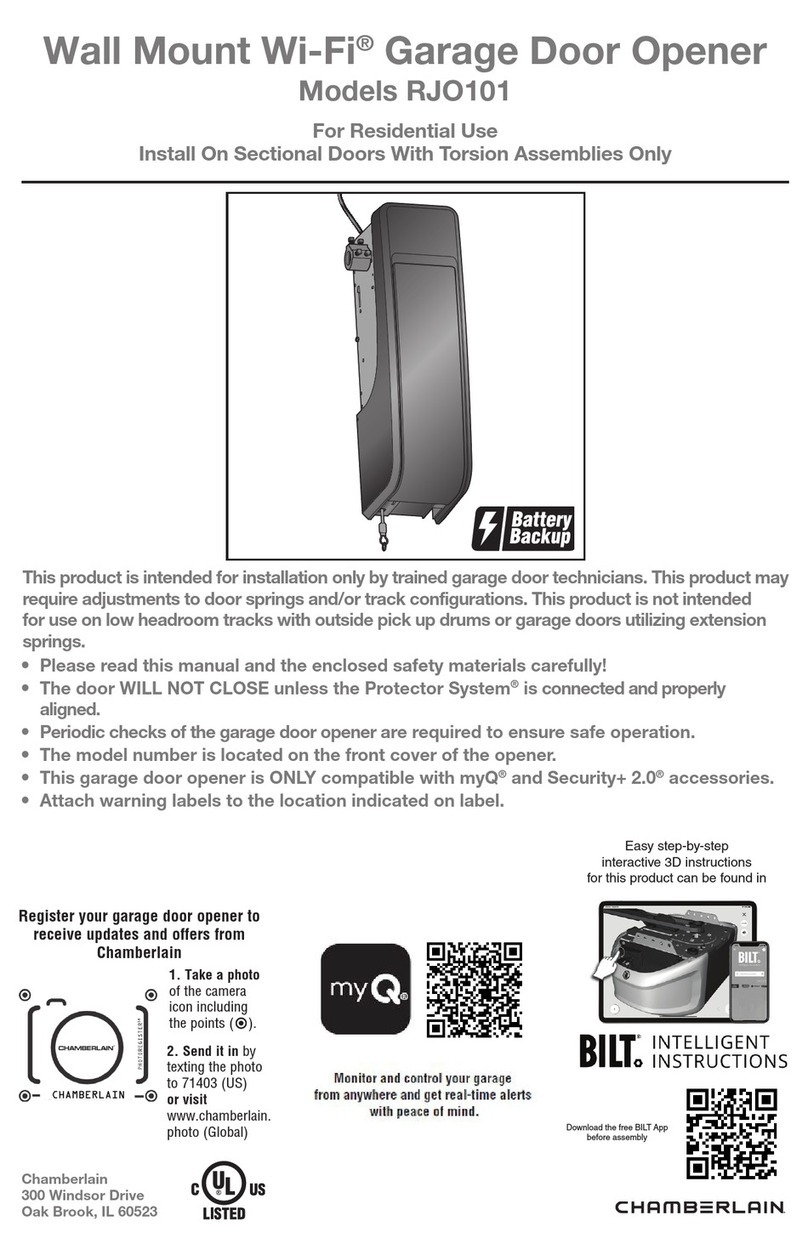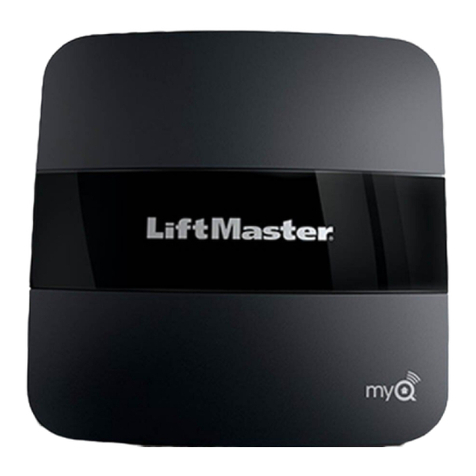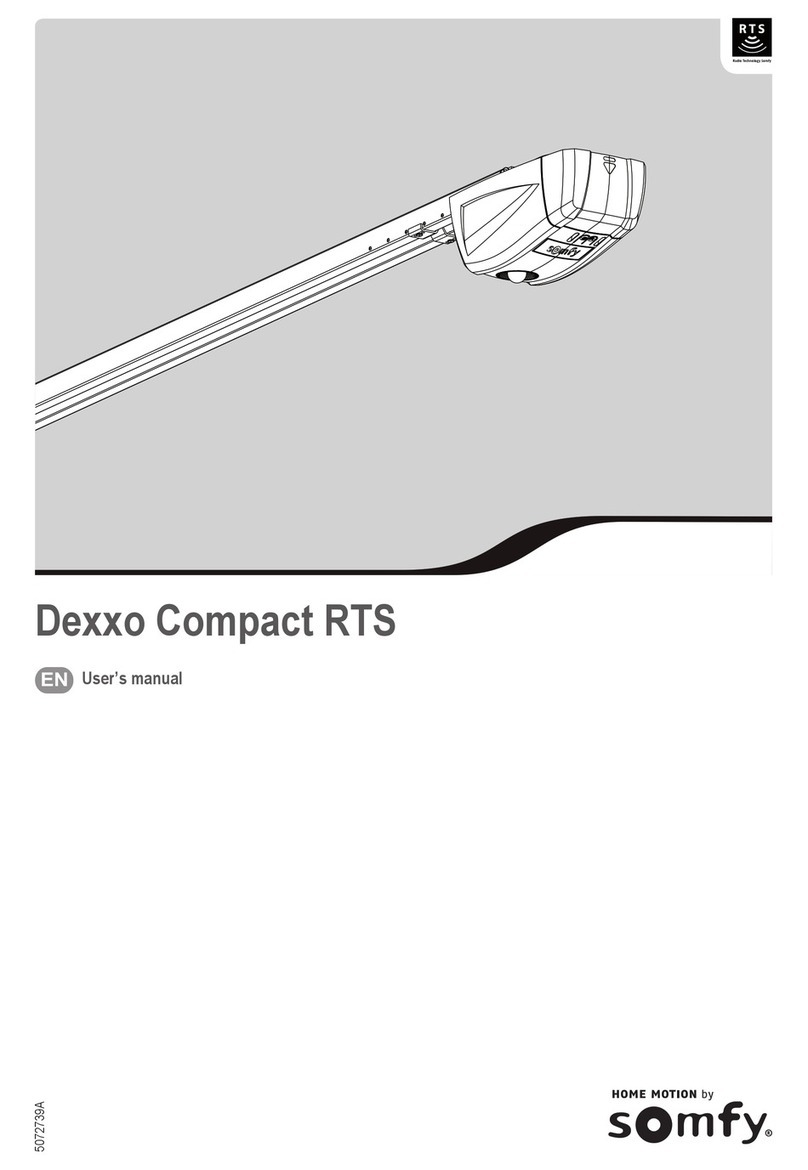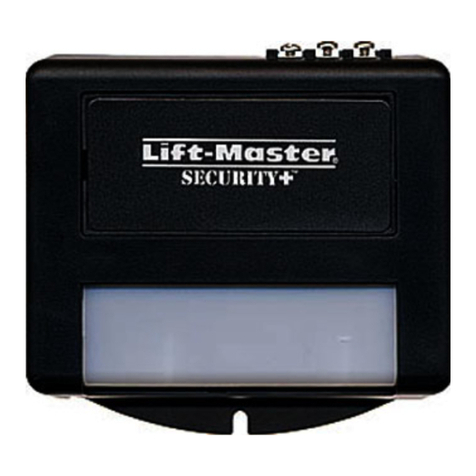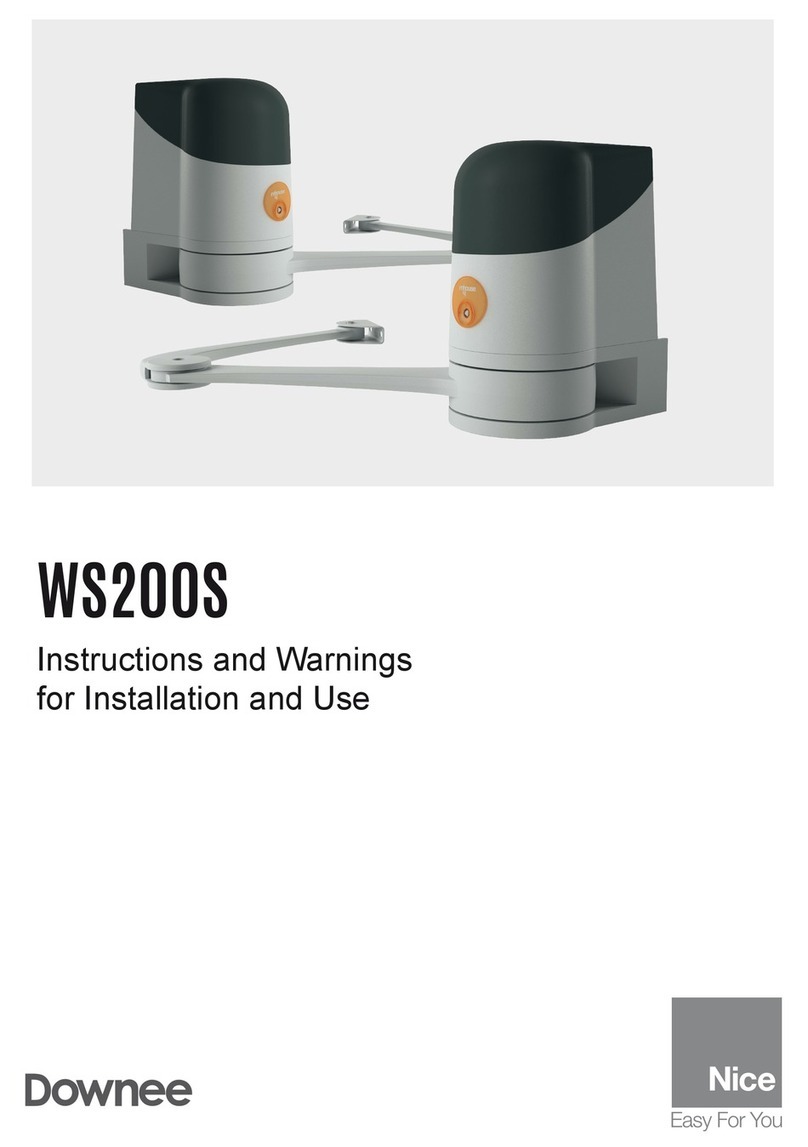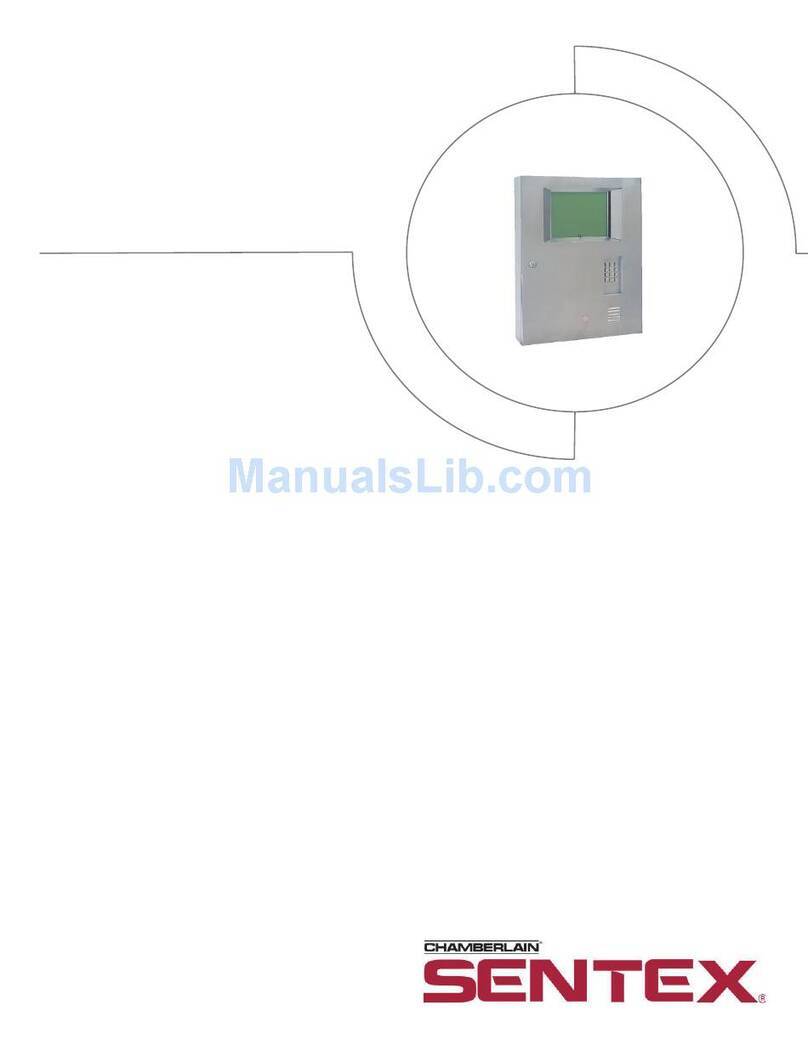Betafence Bekamatic SC 6000 Line User manual

Bekamatic SC pg. 1
Cantilever sliding gates
Bekamatic SC
6000 Line
Installation
Manual

Bekamatic SC pg. 2
Table of Contents
.
1.
Warnings
................................................................................................................................... 3
1.1. Warnings for installer and end user .................................................................................. 3
1.2. Special points to note ............................................................................................................. 3
1.3. Safety rules for end user ....................................................................................................... 5
2.
Guidelines for installation
.............................................................................................. 5
3.
Guidelines for gate lifting
................................................................................................ 6
4.
Foundations
............................................................................................................................. 6
4.1.
Gates opening
to the right
............................................................................. 8
4.2.
Gates opening
to the left
................................................................................. 9
5.
reparations before gate installation:
.................................................................. 10
5.1.
Fixing requirements
................................................................................................. 10
5.2.
Installation of the ground anchors:
.............................................................. 10
5.3.
reparing installation levels:
............................................................................. 11
6.
Installation of the gate onto the ground anchors:
........................................... 12
7. Installation of the lock post onto the ground anchors: ........................................... 13
8.
Alignment
and
levelling
of the
gate:
.................................................................... 13
9.
Adjustment of the mechanical end stops:
.......................................................... 16
9.1.
Adjustment of the front mechanical end buffering:
............................. 16
9.2.
Adjustment of the rear mechanical end
buffer:
...................................... 17
10.
Motor height Adjustment:
............................................................................................. 18
11.
Set-up of the end position:
.......................................................................................... 20
12.
ower Supply:
...................................................................................................................... 20
13.
Adjustment
and
testing of
safety
equipment:
.................................................... 21
13.1.
Wireless transmission system for safety strip
........................................ 21
on the wing
......................................................................................................................................... 21
13.2.
Safety strips:
................................................................................................................ 23
13.3.
hotocells:
..................................................................................................................... 23
14.
Different Set-up systems:
................................................................................... 25
14.1.
Set-up for Bus-system:
......................................................................................... 25
14.2.
Start the Self-Learning procedure
.................................................................. 26
15. Maintenance: ............................................................................................................................. 27
16. Revision: .................................................................................................................................... 27

Bekamatic SC pg. 3
1.
Warnings
These warnings constitute an integral and essential part of the product and must
be issued to the user. Carefully read the warnings in this chapter as they supply
important information concerning the safety issues during installation, use and
maintenance. This handbook must be kept safely for any future consultation.
1.1. Warnings for installer and end user
After removing the packaging, make sure that the equipment is in a good &
serviceable condition. If this is not the case, please do not use the equipment
until it has been checked by professional qualified personnel. Children should not
be allowed to come into contact with packaging elements (plastic bags, expanded
polystyrene, nails, etc.) as they are potential sources of danger.
The installation must be carried out by qualified personnel, which have received
technical training on the product, in accordance with current regulations and
according to the manufacturer’s instructions. The installation regulations can vary
from country to country. Incorrect installation can cause harm to humans,
animals and foreign objects, for which the manufacturer cannot be held
responsible.
In case of a failure and/or poor functioning of the equipment, apply exclusively
only professional qualified personnel, ideally the manufacturer or a certified
installer. Only original spare parts should be used to carry out the repairs to the
product. A lack of observance of that mentioned above could compromise the
safety of the equipment.
This gate should only be used for that what it has been expressly designed for
(the complete system). Any other use breaching this, should be considered
improper and therefore dangerous. Betafence cannot be held responsible for
eventual damage caused by improper, incorrect and unreasonable use.
1.2. Special points to note
- Avoid operating close to mechanical moving components, this could
lead to a dangerous situation, should parts of the body or clothing become
caught up in them. The difficulty of freeing oneself from their grasp is not
always possible and can lead to serious injury.
- Only set the gate in motion when it is completely visible and free from all

Bekamatic SC pg. 4
hazards and obstacles.
- Do not try to stop the gate manually once in motion, this can lead to
damage or serious injury.
- lease note that the gate can generate a considerable force during
operation, which could be a source of danger. Do not move into the
operating area of the gate during motion.
- Do not allow children to play by opening and closing the gate.
- Do not allow children to play within the opening area of the gate.
- Ensure that the wing lock is installed, functioning and locked properly
when the gate wing is closed.
- When you close the door, take care that the lock is in the open position, to
avoid damage to the counter lock on closing (Risk of breaking the lock).
- Ensure that the wing is held properly (manual operation) during the
opening or closing of the gate so that uncontrolled movement of the wing
can be excluded.
Reduce speed when reaching the fully open and fully closed positions to
avoid unnecessary wear when coming into contact with the buffers.
- Under extreme weather conditions (heavy wind), hold the wing securely
during the opening or closing of the gate so that uncontrolled movement of
the wing can be excluded.
- ersons are not allowed to ride on the wing during operation because of
the following crush hazards:
•Between the guiding post and the wing as this can cause serious injuries to
arms and legs.
•Between the guide rollers and catcher as this can cause serious injuries to
hands and fingers.
•Between the support roller and ramp.
•Between the wing and the lock post.
•Between an object at the rear of the wing on opening.
lease adhere to the following to prevent persons from getting caught between
any of these mentioned elements and serious injury.
- Do not climb onto the wing
- Inform all users of these hazards. Ideally this
information should be displayed at a suitable place either on or close to the
gate.
- To guarantee the efficiency of the installation and its correct functioning,
it is imperative that the manufacturers guide lines are observed.

Bekamatic SC pg. 5
1.3. Safety rules for end user
-Attention: In all cases once the gate has been installed and taken into
service the user is, from this point on responsible for his gate.
-The user is responsible for the following:
•That all safety related hazards are correctly controlled
( hotocell, Safety Strips).
•Correct functioning.
•Yearly maintenance.
•Safety Inspection (dependent on country of use)
-Under the safety and correct functioning of the gate it is understood that
the user checks on a regularly basis (minimum once a year) if all safety
devices and access control options are still working properly as they
should.
-Under the yearly maintenance it is understood that the maintenance that
is described by the manufacturer has been followed. If a maintenance
contract between the customer and Betafence exists, Betafence will carry
of this maintenance in cooperation with the user.
-For gates installed in Germany the user must ensure that every 12 months
the gate is inspected as per ASR A 1.7. Once inspected the testing agency
raises a report. If the gate meets all requirements, then this is indicated in
the report and a test sticker is applied to the gate. If the gate fails, then
the faults are captured in the report and communicated to the user. The
user is then responsible for the repairs and the re-submission of the gate
for re-inspection.
-For older gates which have not been built according to DIN EN 13241-1,
the user is obligated legally to ensure that his gate meets all new
standards / regulations issued.
2.
Guidelines for installation
•Only licensed technicians or installers who have had adequate
product training provided by Betafence should be permitted to install
the gate.
•The integration of the gate into a fence must not create additional
dangers / hazards. lease read carefully the warning document and
consider the integration examples in the document package
delivered with the gate.

Bekamatic SC pg. 6
•The connection to the electrical power supply must be carried out by a
qualified technician and in accordance with the regulations and
standards that are applicable in the country of installation.
3.
Guidelines for gate lifting
•Gates are delivered to the
construction site completely
assembled.
•Lift-up points for
unloading and
positioning during
the installation.
•The gate may only be lifted using the correct lifting tackle. This should
have an up to date test certificate and be sufficiently dimensioned for
the weight of the gate. By preference use undamaged flexible lift
slings with sufficient lifting capacity.
4.
Foundations
•
Foundations prepared according
to the
corresponding drawing.
-For standard range of gates see page 5 and 6. For the
drawings and dimensions see page 7.
-For all non-standard executions and gate combinations, please
consult the special foundation drawings supplied with the gate.
-The gate must not be installed following the slope of the
construction site. Make sure that the foundation for the lock post
is at the same level as the foundation for the guiding post.
-1 cable pipe for the connection between the power source and
the gate guiding post.
-Install an extra cable pipe between the gate and the place of
operating (signal cables).
-1 cable pipe for the cable connections between the guiding
post and the lock post ( hotocells).
-DO NOT L Y SIGN L C BLES IN THE POWER SUPPLY
C BLE PIPE!

Bekamatic SC pg. 7
Warning:
THE FOUNDATION LANS ROVIDED ON THE FOLLOWING
AGES SERVE ONLY AS AN EXAM LE!
ALWAYS USE THE LANS ROVIDED WITH THE ORDER
DOCUMENT.
•
C
oncrete quality:
C25 = cubic
pressure resistance
25
N/mm
2
.

Bekamatic SC pg. 8
4.1.
Gates opening
to the right

Bekamatic SC pg. 9
4.2.
Gates opening
to the left

[Hie
Bekamatic SC pg. 10
r eingeben] [Hier eingeben] [Hier eingeben]
5.
Preparations before gate installation:
5.1.
Fixing requirements
•Chemical anchors M16 x 250 mm with “Fender” type washers
(minimum 125 mm anchor depth and minimum 100 mm above finished
Ground Level).
•For the mounting and securing of:
-Guiding post (4 anchors)
-Lock post (4 anchors)
-Rear guiding roller set (4 anchors)
•Chemical anchors M10 x 200 mm. 4 anchors for the mounting and
securing of the support roller assembly (when fully open
)
.
W RNING!
DO NOT USE MECH NIC L NCHORS S THEY RE NOT
SUIT BLE FOR THIS PPLIC TION!
The max distance between the concrete and post base plate should not be more
than 50mm. Otherwise the stability is reduced.
(Within the warranty period, should the user report that “the gate does not move
smoothly” and it is established that the gate position is not correct while this rule
has not been followed, then the claim will not be accepted).
5.2.
Installation of the ground anchors:
1)
Lay a tension line through the central axis of
the foundations to indicate the exact position
where the gate is to be installed. This
incorporates the lock post, the guide post, the
rear roller assembly and the rear support
roller.
2)
osition the templates for the guiding and lock
posts and rear roller assembly. Using the
tension line as a guide, align the center
markings of the templates, ensure that the
distances between the templates are adhered
to as laid down in the foundation plans
provided with the order document.
3)
Mark the position of the holes with a small diameter concrete drill.
This will help to centralize the final drilling to the required diameter.

[Hie
Bekamatic SC pg. 11
r eingeben] [Hier eingeben] [Hier eingeben]
4)
Drill the corresponding holes for the fixation
of the chemical anchors according to the
supplier’s installation instructions. Drilled
holes must be vertical.
5)
Remove any dust and small particles from the
drill holes using a brush and hand pump. This
will ensure perfect adhesion between the
resin, ground anchor and the concrete
foundation.
6)
lace the chemical anchors according to
the supplier’s instructions. Resin drying
times must be observed.
5.3.
Preparing installation levels:
1) Screw the lower adjustment nuts onto their
ground anchors some 25mm above the
concrete and place the 3D washers onto the
nuts.
2) Using a spirit level (see photo) adjust the
height of all 4 nuts so that they are horizontal
to one and other. The guiding post position
serves as a reference point for the installation
of the other main components (Roller
assembly, lock post and support roller).
3) The nuts of each mounting position (rear roller
assembly and lock post) should be perfectly
horizontal and relative to another, so that the
horizontal and vertical positions for the main
support elements of the gate are correctly
aligned before the gate is lowered onto the
anchors.

[Hie
Bekamatic SC pg. 12
r eingeben] [Hier eingeben] [Hier eingeben]
6.
Installation of the gate onto the ground
anchors:
Important:
Ensure your electrical cables have been passed through the cable pipes that are
provided in the concrete. This enables an easier installation of the cables into the
main guide post.
The cables should protrude at least 1500mm above the concrete.
Once this has been established the installation of the gate can begin.
1) The gate is positioned as a complete unit with
the guiding post and the rear roller assembly
onto their corresponding ground anchors.
2) Chronological order of actions:
1) Remove packaging from the guiding post. Do not remove the
strap that holds the under beam and base plate together.
2) osition the gate with the guiding post above the ground
anchors approximately 500mm above the ground.
3) Open the main upper access door of
the guiding post cabinet.
Open the small lower door of
the guiding post cabinet.
4) Identify the cables which go to the end
post (photocells, key switch etc.).
5) ull these cables through the cable
pipe to the lock post.
6) ass the exposed ends of the power
supply and other cables through the
hole in the base plate of the guiding
post into the cabinet.
7) Cut off the straps which hold the rear
roller assembly to the under beam.
8) Now lower the gate until the rear roller
assembly and the guiding post are
resting on the washers of the ground
anchors. Fit a washer and nut to each
ground anchor. Tighten the nuts slightly
for temporary fixation. Remove straps
from the base plate of the guiding post.

[Hie
Bekamatic SC pg. 13
r eingeben] [Hier eingeben] [Hier eingeben]
TTENTION!
Ensure that cables and wires are not crushed between surfaces
while lowering and positioning the gate onto the ground
anchors.
7. Installation of the lock post onto the ground
anchors:
1) Remove the lock post from the gate wing and
suspend it over its ground anchors. ull out
the cables from under the lock post and
connect the corresponding (colour-coded)
connectors together. We have provided one or
two boxes with connectors for these
connections.
2) ush the cables back into the tube of the lock post until the
connectors are also in the tube. This will protect them against water
and will facilitate the uninstalling (replacement) of photocells.
3) osition the lock post onto the ground anchors and install the upper
washers with nuts. Tighten the nuts slightly for temporary fixation.
8.
lignment
and
levelling
of the
gate:
1) ut the gate in manual (disengaged)
mode by turning the red sling
clockwise.
2) Align the rear roller assembly and the
guiding post according to the gate
center axis line. Ensure that the wing
is running parallel through the
guiding post.
The guiding post and the rear roller assembly can be moved laterally
in the oblong holes of the base plates.
Once the alignment between the rear roller assembly and the guiding
post is complete, slightly tighten the ground anchor nuts of the guiding
post and rear roller assembly.
Check if the gate moves freely by hand over the complete span of
the wing during opening and closing. Do this slowly as not all
adjustments are done.

[Hie
Bekamatic SC pg. 14
r eingeben] [Hier eingeben] [Hier eingeben]
3) Close the gate almost completely by hand and
align the lock post. Make sure that the guiding
rollers on top of the wing enter the catcher
centrally. If excessive force is being exerted
onto one of the catcher sides, then the set-up
is not acceptable (this indicates misalignment).
4) osition the wing such that the rear roller
assembly and guide post support it. lace a
spirit level between the two sets of rollers.
Adjust the level of the wing by means of the
rear roller assembly ground anchor nuts. Keep
the base plate level.
W RNING!
DO NOT ADJUST THE M10 NUTS AND BOLTS
WHICH SECURE THE ROLLER ASSEMBLY TO
THE BASE LATE:
5) After alignment of the lock post and horizontal
levelling of the wing, adjust the height of the
lock post so that the support wheel under the
front of the under beam is just touching the
ramp (of the lock post). Ensure that the
vertical level and position in the catcher is
maintained. The height adjustment is made
with the ground anchor nuts.
TTENTION!
The support wheel in the under beam must not
be forced up the ramp to enter the lock post.
6) After full adjustment of the gate, tighten all ground anchor nuts. Then
cut the lengths of the ground anchor bolts to 5mm above the nuts,
and paint with corrosion resistant paint (Do this only when the gate
function has been tested and the installation is complete).
7) Gates with a free passage of more than 6000mm have a roller to
support the wing in the open position. The installation of this support
roller is described in paragraph 8.

[Hie
Bekamatic SC pg. 15
r eingeben] [Hier eingeben] [Hier eingeben]
8) Correct adjustment of this roller is crucial for the correct functioning
of the gate.
9) The roller must be adjusted in height but also, it’s perpendicularity in
relation to the under beam of the wing.
10) A support roller installed too high will add undesired friction to the
wing which increases the further the wing is opened.
11) The height of the support roller must be
adjusted once the wing is approximately
500mm away from the completely open
position.
12) In this position the support roller should
start to contact the under beam. Adjust
the height as necessary.
Do
not
adjust
the
tensioning system
Supp rt R ller Rear R ller
Assembly
Fr nt R ller
Assembly Main
Guide P st

[Hie
Bekamatic SC pg. 16
r eingeben] [Hier eingeben] [Hier eingeben]
0°
<
90°
9.
djustment of the mechanical end stops:
TTENTION!
The verification and/or the adjustment of the mechanical end buffering
must always be carried out. When the end buffering is not adjusted
properly it may cause severe irreversible damage to some parts of the
gate.
The mechanical end buffering is located on the front and rear roller
assemblies found in the under beam. To gain access to them, the front
and rear end caps of the under beam must be removed.
9.1.
djustment of the front mechanical end
buffering:
If the gate is installed correctly according to the foundation plan, then the
front buffer does not need to be adjusted as the factory default setting of
60mm will be sufficient.
However, if there is some deviation from the foundation plan,
or an obstacle at the rear side of the gate prevents the wing
opening over its full course, then adjust according to the
description below.
1) ull the lower part of the safety pressure strip from its
aluminum fixation profile.
2) Remove the front cover plate from the under beam by
unscrewing the 4 screws (2 on each side).
3) Loosen the counter nut. Turn the
threaded rod anti-clockwise so that the rubber stop
protrudes out of the under beam by 5mm to 10mm.
Retighten the counter nut.
4) Replace the cover plate to close the under beam and tighten the screws
with moderate force.
Remarks:
It’s very imp rtant t fill the space under the plate f the Guiding and l ck p st
with shrinkage-c mpensated c ncrete.

[Hie
Bekamatic SC pg. 17
r eingeben] [Hier eingeben] [Hier eingeben]
5) Refit the safety pressure strip into the aluminum profile.
To aid this, spray some silicone lubricant onto the rubber
profile on the rear of the strip and push it into place.
9.2.
djustment of the rear mechanical end
buffer:
The rear mechanical end buffer is an integral part of the rear roller
assembly and is adjustable in length up to 450mm maximum (Exception:
for gates up to 4000mm the adjustable length is up to 200mm
maximum). This is the maximum adjustment with allows a good
functioning of the gate under the applied forces. Therefore, we strongly
advise, always adhere to the dimensions laid down in the foundation
plans.
1) Remove the rear cover plate from the under beam
by unscrewing the 4 screws (2 on each side).
2) Close the gate so that there is 10mm to 20mm
between the upper guiding rollers on top of the
wing and the bottom of the catcher on the lock
post.
3) Loosen the counter nut. Turn the threaded rod anti-
clockwise so that the rubber stop protrudes out of
the under beam by 5mm to 10mm.
Re-tighten the counter nut.
4) Replace the cover plate to close the under beam and tighten the screws
with moderate force.

[Hie
Bekamatic SC pg. 18
r eingeben] [Hier eingeben] [Hier eingeben]
10.
Motor height djustment:
1) lace the wing into the position where it is being supported by both the
front and rear roller assemblies.
2) Turn the red sling anti-clockwise to engage the motor and gearbox.
3) Adjust the height of the pinion by turning the M12 nut allowing the
spring to raise the drive assembly upwards. Raise until the dental wheel
is fully meshed with the dental rack.
The spring ensures that a good meshing between dental rack and
dental wheel is maintained during movement.

[Hie
Bekamatic SC pg. 19
r eingeben] [Hier eingeben] [Hier eingeben]
4) The height of the dental wheel is very important and in
combination with a correctly levelled wing ensures a trouble-free
operation (See set up Menu 8 ara 4).
The normal rule is 1.5 mm space between dental wheel and dental
rack.
Once the adjustment has been done. Move the wing over the complete
length of movement observing the dental wheel and rack.
Should meshing problems occur in certain positions, these can be
regulated by either moving the dental rack up or down on the under-
beam (oblong holes).
5) Disengage the gearbox by turning the red sling
clockwise
6) Move the wing back and forth by a small amount. Check that the dental
wheel is engaged over the whole width of the dental rack. If not, adjust
the dental rack.

[Hie
Bekamatic SC pg. 20
r eingeben] [Hier eingeben] [Hier eingeben]
11.
Set-up of the end position:
1) Fully open the gate and move the detection block on
the dental rack in front of the sensor for open. You will
hear a “click” and the LED ‘FCA1’ switches off.
osition for open is OK.
2) Move the wing to the closed position. Now move the second
detection block in front of the sensor for closed. You will hear a
“click” and the LED ‘FCC1’ switches off. osition for close is ok.
3) Now move the wing manually into the open and closed positions,
checking that the position of the wing in relation to the LED’s in the
steering is switching correctly.
12.
Power Supply:
1) ower source must be 230V AC. Connect the power supply cable to
the main switch connectors. There are three connectors foreseen for
connection of the power supply. The cable from the main board to the
gate must be secured according to the latest electrical installation
regulations.
Use a low voltage solid cable with a section according to the table
underneath. (For example: NYJZ 3 x 2,5mm
2
according to VDE0276 part
603, VDE 0271 and IEC 52)
Section (mm
2
)
Maximum
distance
(m)
2.
5
300
4
600
6 900
Only activ
e,
if
no
Limit switch is
activated.
Limit switch
Detecti n bl ck
Table of contents
Popular Garage Door Opener manuals by other brands

Raynor
Raynor COMMANDER 2000RGD owner's manual
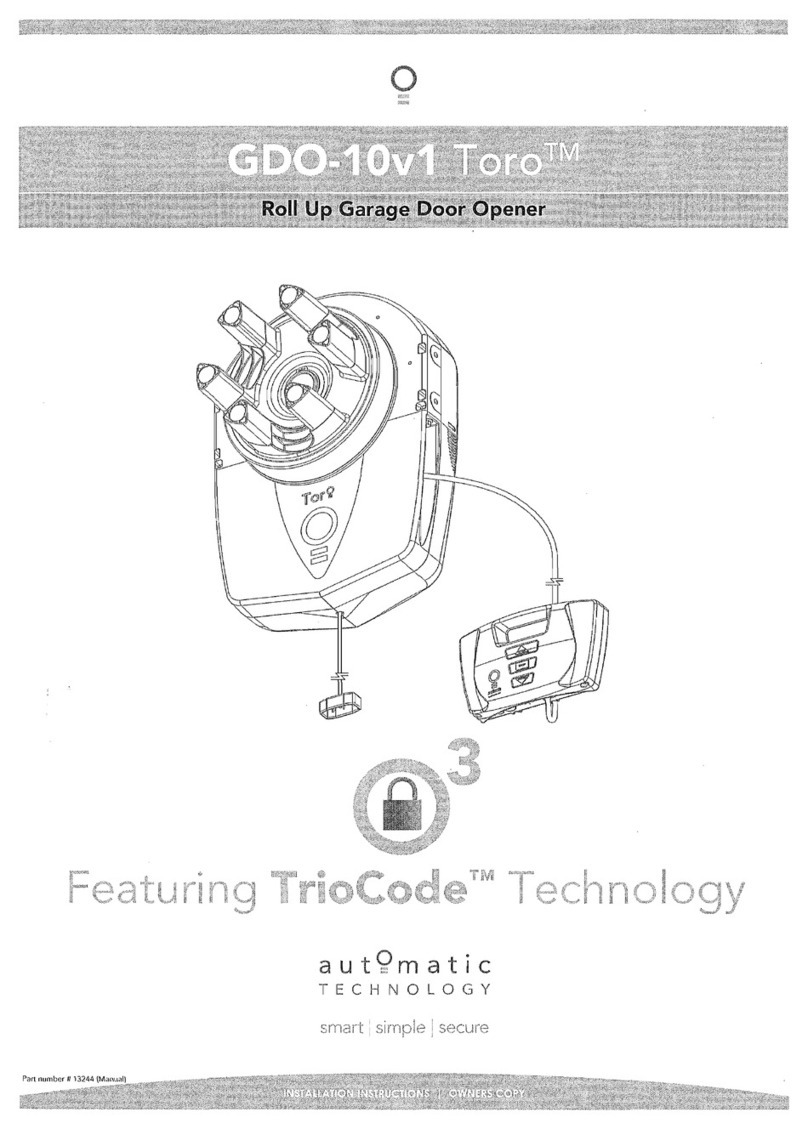
Automatic Technology
Automatic Technology GDO-10v1 Toro installation instructions
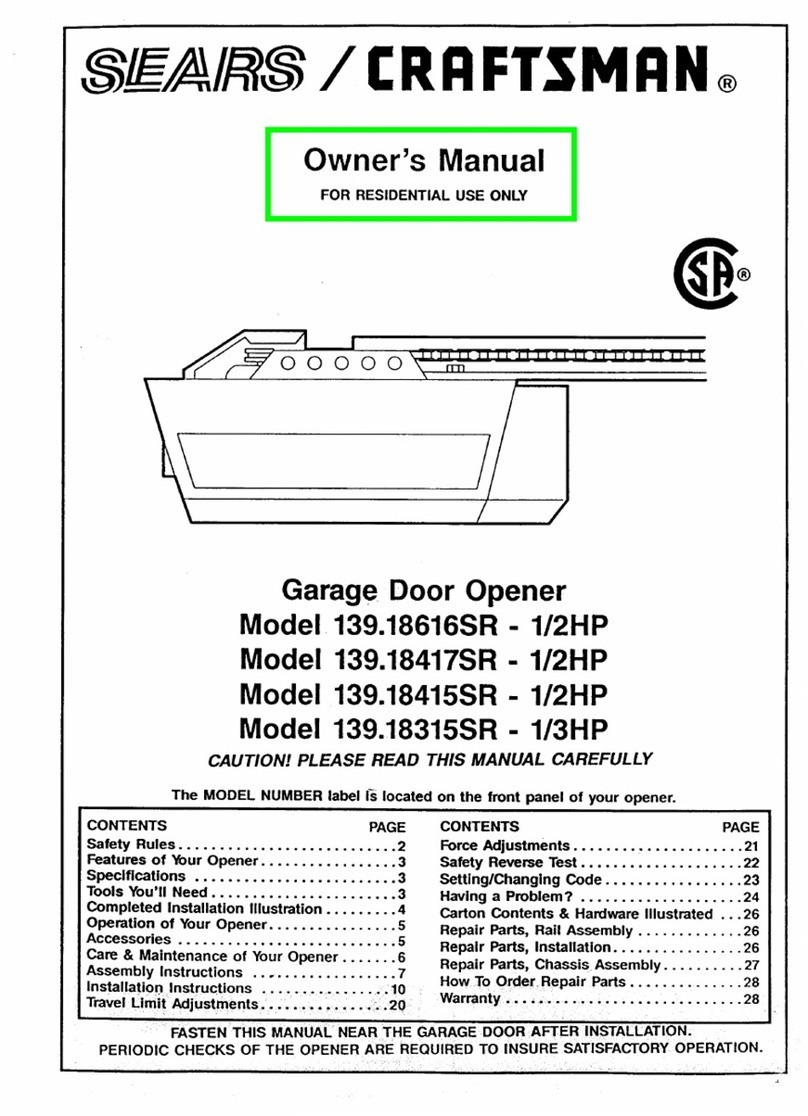
Craftsman
Craftsman 139.18616SR owner's manual
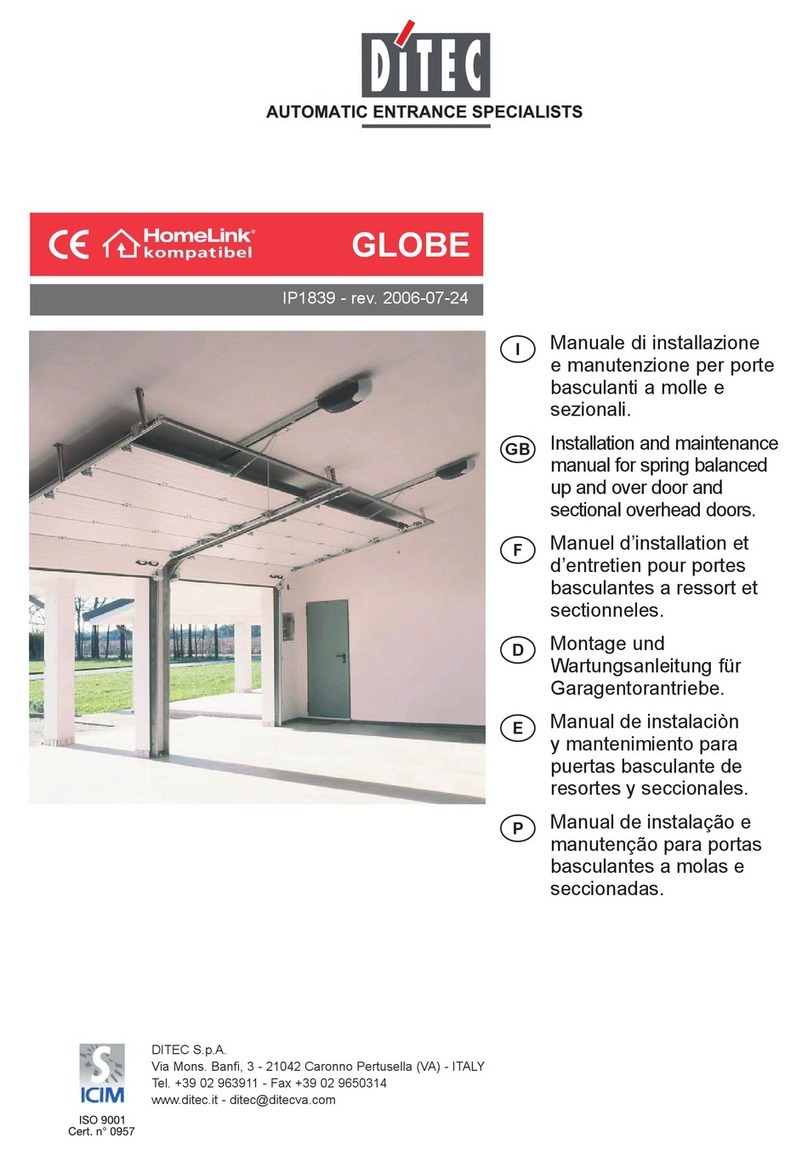
DITEC
DITEC GLOBE Installation and maintenance manual

SOMFY
SOMFY Dexxo Pro Commissioning instructions
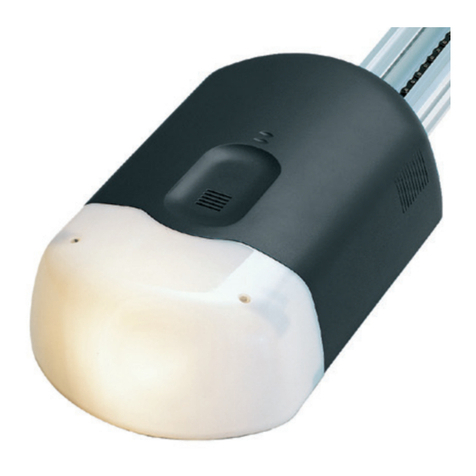
Cardin Elettronica
Cardin Elettronica GL112409 Installation
